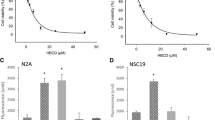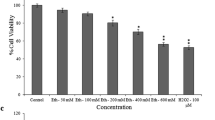Abstract
Methylmercury (MeHg) and polychlorinated biphenyls (PCBs) are widespread environmental pollutants commonly found as contaminants in the same food sources. Even though their neurotoxic effects are established, the mechanisms of action are not fully understood. In the present study, we have used the mouse hippocampal neuronal cell line HT22 to investigate the mechanisms of neuronal death induced by MeHg, PCB 153, and PCB 126, alone or in combination. All chemicals induced cell death with morphological changes compatible with either apoptosis or necrosis. Mitochondrial functions were impaired as shown by the significant decrease in mitochondrial Ca2+ uptake capacity and ATP levels. MeHg, but not the PCBs, induced loss of mitochondrial membrane potential and release of cytochrome c into the cytosol. Also, pre-treatment with the antioxidant MnTBAP was protective only against cell death induced by MeHg. While caspase activation was absent, the Ca2+-dependent proteases calpains were activated after exposure to MeHg or the selected PCBs. Furthermore, lysosomal disruption was observed in the exposed cells. Accordingly, pre-treatment with the calpain specific inhibitor PD150606 and/or the cathepsin D inhibitor Pepstatin protected against the cytotoxicity of MeHg and PCBs, and the protection was significantly enhanced when the two inhibitors were combined. Simultaneous exposures to lower doses of MeHg and PCBs suggested mostly antagonistic interactions. Taken together, these data indicate that MeHg and PCBs induce caspase-independent cell death via parallel activation of calpains and lysosomal proteases, and that in this model oxidative stress does not play a major role in PCB toxicity.






Similar content being viewed by others
References
Ahlbom E, Gogvadze V, Chen M, Celsi G, Ceccatelli S (2000) Prenatal exposure to high levels of glucocorticoids increases the susceptibility of cerebellar granule cells to oxidative stress-induced cell death. Proc Natl Acad Sci USA 97:14726–14730
Arena SM, Greeley EH, Halbrook RS, Hansen LG, Segre M (2003) Biological effects of gestational and lactational PCB exposure in neonatal and juvenile C57BL/6 mice. Arch Environ Contam Toxicol 44:272–280
Bemis JC, Seegal RF (2000) Polychlorinated biphenyls and methylmercury alter intracellular calcium concentrations in rat cerebellar granule cells. Neurotoxicology 21:1123–1134
Bliss CI (1939) The toxicity of poisons applied jointly. Ann Appl Biol 26:585–615
Brunk UT, Dalen H, Roberg K, Hellquist HB (1997) Photo-oxidative disruption of lysosomal membranes causes apoptosis of cultured human fibroblasts. Free Radic Biol Med 23:616–626
Burton GV, Meikle AW (1980) Acute and chronic methyl mercury poisoning impairs rat adrenal and testicular function. J Toxicol Environ Health 6:597–606
Castoldi AF, Coccini T, Ceccatelli S, Manzo L (2001) Neurotoxicity and molecular effects of methylmercury. Brain Res Bull 55:197–203
Choi BH, Lapham LW, Amin-Zaki L, Saleem T (1978) Abnormal neuronal migration, deranged cerebral cortical organization, and diffuse white matter astrocytosis of human fetal brain: a major effect of methylmercury poisoning in utero. J Neuropathol Exp Neurol 37:719–733
Damelin LH, Vokes S, Whitcutt JM, Damelin SB, Alexander JJ (2000) Hormesis: a stress response in cells exposed to low levels of heavy metals. Hum Exp Toxicol 19:420–430
Dare E, Li W, Zhivotovsky B, Yuan X, Ceccatelli S (2001a) Methylmercury and H(2)O(2) provoke lysosomal damage in human astrocytoma D384 cells followed by apoptosis. Free Radic Biol Med 30:1347–1356
Dare E, Gorman AM, Ahlbom E, Gotz M, Momoi T, Ceccatelli S (2001b) Apoptotic morphology does not always require caspase activity in rat cerebellar granule neurons. Neurotox Res 3:501–514
Day BJ, Fridovich I, Crapo JD (1997) Manganic porphyrins possess catalase activity and protect endothelial cells against hydrogen peroxide-mediated injury. Arch Biochem Biophys 347:256–262
Ehrenberg B, Montana V, Wei MD, Wuskell JP, Loew LM (1988) Membrane potential can be determined in individual cells from the nernstian distribution of cationic dyes. Biophys J 53:785–794
Falluel-Morel A, Sokolowski K, Sisti HM, Zhou X, Shors TJ, Dicicco-Bloom E (2007) Developmental mercury exposure elicits acute hippocampal cell death, reductions in neurogenesis, and severe learning deficits during puberty. J Neurochem 103:1968–1981
Faroon OM, Keith S, Jones D, de Rosa C (2001) Effects of polychlorinated biphenyls on development and reproduction. Toxicol Ind Health 17:63–93
Gilbert ME, Mundy WR, Crofton KM (2000) Spatial learning and long-term potentiation in the dentate gyrus of the hippocampus in animals developmentally exposed to Aroclor 1254. Toxicol Sci 57:102–111
Goldoni M, Johansson C (2007) A mathematical approach to study combined effects of toxicants in vitro: evaluation of the Bliss independence criterion and the Loewe additivity model. Toxicol In Vitro 21:759–769
Gorman AM, Hirt UA, Orrenius S, Ceccatelli S (2000) Dexamethasone pre-treatment interferes with apoptotic death in glioma cells. Neuroscience 96:417–425
Grady RR, Kitay JI, Spyker JM, Avery DL (1978) Postnatal endocrine dysfunction induced by prenatal methylmercury or cadmium exposure in mice. J Environ Pathol Toxicol 1:187–197
Grandjean P, Weihe P, White RF, Debes F, Araki S, Yokoyama K, Murata K, Sorensen N, Dahl R, Jorgensen PJ (1997) Cognitive deficit in 7-year-old children with prenatal exposure to methylmercury. Neurotoxicol Teratol 19:417–428
Greco WR, Unkelbach HD, Pöch G, Sühnel J, Kundi M, Bödeker W (1992) Consensus on concepts and terminology for combined-action assessment: the Saariselkä agreement. Arch Complex Environ Stud 4:65–69
Greco WR, Bravo G, Parsons JC (1995) The search for synergy: a critical review from a response surface perspective. Pharmacol Rev 47:331–385
Holene E, Nafstad I, Skaare JU, Sagvolden T (1998) Behavioural hyperactivity in rats following postnatal exposure to sub-toxic doses of polychlorinated biphenyl congeners 153 and 126. Behav Brain Res 94:213–224
Howard AS, Fitzpatrick R, Pessah I, Kostyniak P, Lein PJ (2003) Polychlorinated biphenyls induce caspase-dependent cell death in cultured embryonic rat hippocampal but not cortical neurons via activation of the ryanodine receptor. Toxicol Appl Pharmacol 190:72–86
Humphrey HE, Gardiner JC, Pandya JR, Sweeney AM, Gasior DM, McCaffrey RJ, Schantz SL (2000) PCB congener profile in the serum of humans consuming Great Lakes fish. Environ Health Perspect 108:167–172
Johansson C, Tofighi R, Tamm C, Goldoni M, Mutti A, Ceccatelli S (2006) Cell death mechanisms in AtT20 pituitary cells exposed to polychlorinated biphenyls (PCB 126 and PCB 153) and methylmercury. Toxicol Lett 167:183–190
Johansson C, Castoldi AF, Onishchenko N, Manzo L, Vahter M, Ceccatelli S (2007) Neurobehavioural and molecular changes induced by methylmercury exposure during development. Neurotox Res 11:241–260
Kakita A, Wakabayashi K, Su M, Yoneoka Y, Sakamoto M, Ikuta F, Takahashi H (2000) Intrauterine methylmercury intoxication. Consequence of the inherent brain lesions and cognitive dysfunction in maturity. Brain Res 877:322–330
Kang JH, Park IS, Oh WY, Lim HK, Wang SY, Lee SY, Choi KH, Kim JI, Jung SY, Suh CK, Kim DS (2004) Inhibition of aroclor 1254-induced depletion of stored calcium prevents the cell death in catecholaminergic cells. Toxicology 200:93–101
Kim JS, He L, Lemasters JJ (2003) Mitochondrial permeability transition: a common pathway to necrosis and apoptosis. Biochem Biophys Res Commun 304:463–470
Kodavanti PR (2005) Neurotoxicity of persistent organic pollutants: possible mode(s) of action and further considerations. Dose Response 3:273–305
Kodavanti PR, Tilson HA (1997) Structure–activity relationships of potentially neurotoxic PCB congeners in the rat. Neurotoxicology 18:425–441
Kodavanti PR, Tilson HA (2000) Neurochemical effects of environmental chemicals: in vitro and in vivo correlations on second messenger pathways. Ann N Y Acad Sci 919:97–105
Lanting CI, Huisman M, Muskiet FA, van der Paauw CG, Essed CE, Boersma ER (1998) Polychlorinated biphenyls in adipose tissue, liver, and brain from nine stillborns of varying gestational ages. Pediatr Res 44:222–225
Lee SH, Youk ES, Jeon YJ, Han SB, Kim HC, Kim HM (2001) Polychlorinated biphenyls activate caspase-3-like death protease in vitro but not in vivo. Biol Pharm Bull 24:1380–1383
Leist M, Single B, Castoldi AF, Kuhnle S, Nicotera P (1997) Intracellular adenosine triphosphate (ATP) concentration: a switch in the decision between apoptosis and necrosis. J Exp Med 185:1481–1486
Lendahl U, McKay RD (1990) The use of cell lines in neurobiology. Trends Neurosci 13:132–137
Li P, Nijhawan D, Budihardjo I, Srinivasula SM, Ahmad M, Alnemri ES, Wang X (1997) Cytochrome c and dATP-dependent formation of Apaf-1/caspase-9 complex initiates an apoptotic protease cascade. Cell 91:479–489
Mariussen E, Myhre O, Reistad T, Fonnum F (2002) The polychlorinated biphenyl mixture aroclor 1254 induces death of rat cerebellar granule cells: the involvement of the N-methyl-d-aspartate receptor and reactive oxygen species. Toxicol Appl Pharmacol 179:137–144
Marty MS, Atchison WD (1997) Pathways mediating Ca2+ entry in rat cerebellar granule cells following in vitro exposure to methyl mercury. Toxicol Appl Pharmacol 147:319–330
Marty MS, Atchison WD (1998) Elevations of intracellular Ca2+ as a probable contributor to decreased viability in cerebellar granule cells following acute exposure to methylmercury. Toxicol Appl Pharmacol 150:98–105
Meacham CA, Freudenrich TM, Anderson WL, Sui L, Lyons-Darden T, Barone S Jr, Gilbert ME, Mundy WR, Shafer TJ (2005) Accumulation of methylmercury or polychlorinated biphenyls in in vitro models of rat neuronal tissue. Toxicol Appl Pharmacol 205:177–187
Morimoto BH, Koshland DE Jr (1990) Induction and expression of long- and short-term neurosecretory potentiation in a neural cell line. Neuron 5:875–880
Nath R, Raser KJ, Stafford D, Hajimohammadreza I, Posner A, Allen H, Talanian RV, Yuen P, Gilbertsen RB, Wang KK (1996) Non-erythroid alpha-spectrin breakdown by calpain and interleukin 1 beta-converting-enzyme-like protease(s) in apoptotic cells: contributory roles of both protease families in neuronal apoptosis. Biochem J 319(Pt 3):683–690
Niemi WD, Audi J, Bush B, Carpenter DO (1998) PCBs reduce long-term potentiation in the CA1 region of rat hippocampus. Exp Neurol 151:26–34
Onishchenko N, Tamm C, Vahter M, Hokfelt T, Johnson JA, Johnson DA, Ceccatelli S (2007) Developmental exposure to methylmercury alters learning and induces depression-like behavior in male mice. Toxicol Sci 97:428–437
Orrenius S, Zhivotovsky B, Nicotera P (2003) Regulation of cell death: the calcium-apoptosis link. Nat Rev Mol Cell Biol 4:552–565
Ribas-Fito N, Sala M, Kogevinas M, Sunyer J (2001) Polychlorinated biphenyls (PCBs) and neurological development in children: a systematic review. J Epidemiol Community Health 55:537–546
Rice DC (1996) Evidence for delayed neurotoxicity produced by methylmercury. Neurotoxicology 17:583–596
Robertson JD, Zhivotovsky B, Gogvadze V, Orrenius S (2003) Outer mitochondrial membrane permeabilization: an open-and-shut case? Cell Death Differ 10:485–487
Rossi AD, Ahlbom E, Ogren SO, Nicotera P, Ceccatelli S (1997) Prenatal exposure to methylmercury alters locomotor activity of male but not female rats. Exp Brain Res 117:428–436
Sarafian T, Verity MA (1991) Oxidative mechanisms underlying methyl mercury neurotoxicity. Int J Dev Neurosci 9:147–153
Seegal RF (1996) Epidemiological and laboratory evidence of PCB-induced neurotoxicity. Crit Rev Toxicol 26:709–737
Szabo C, Day BJ, Salzman AL (1996) Evaluation of the relative contribution of nitric oxide and peroxynitrite to the suppression of mitochondrial respiration in immunostimulated macrophages using a manganese mesoporphyrin superoxide dismutase mimetic and peroxynitrite scavenger. FEBS Lett 381:82–86
Tagliaferri S, Caglieri A, Goldoni M, Pinelli S, Alinovi R, Poli D, Pellacani C, Giordano G, Mutti A, Costa LG (2010) Low concentrations of the brominated flame retardants BDE-47 and BDE-99 induce synergistic oxidative stress-mediated neurotoxicity in human neuroblastoma cells. Toxicol In Vitro 24:116–122
Tilson HA, Kodavanti PR (1998) The neurotoxicity of polychlorinated biphenyls. Neurotoxicology 19:517–525
Tilson HA, Jacobson JL, Rogan WJ (1990) Polychlorinated biphenyls and the developing nervous system: cross-species comparisons. Neurotoxicol Teratol 12:239–248
Vettori MV, Goldoni M, Caglieri A, Poli D, Folesani G, Ceccatelli S, Mutti A (2006) Antagonistic effects of methyl-mercury and PCB153 on PC12 cells after a combined and simultaneous exposure. Food Chem Toxicol 44:1505–1512
Volbracht C, Leist M, Kolb SA, Nicotera P (2001) Apoptosis in caspase-inhibited neurons. Mol Med 7:36–48
Winneke G, Walkowiak J, Lilienthal H (2002) PCB-induced neurodevelopmental toxicity in human infants and its potential mediation by endocrine dysfunction. Toxicology 181–182:161–165
Yee S, Choi BH (1994) Methylmercury poisoning induces oxidative stress in the mouse brain. Exp Mol Pathol 60:188–196
Acknowledgments
We thank Dr. Maria Vittoria Vettori and Dr Anna Castoldi for valuable discussions. This work was supported by grants from the European Commission (DEVNERTOX, ATHON) and the Swedish Research Council FORMAS.
Author information
Authors and Affiliations
Corresponding author
Rights and permissions
About this article
Cite this article
Tofighi, R., Johansson, C., Goldoni, M. et al. Hippocampal Neurons Exposed to the Environmental Contaminants Methylmercury and Polychlorinated Biphenyls Undergo Cell Death via Parallel Activation of Calpains and Lysosomal Proteases. Neurotox Res 19, 183–194 (2011). https://doi.org/10.1007/s12640-010-9159-1
Received:
Revised:
Accepted:
Published:
Issue Date:
DOI: https://doi.org/10.1007/s12640-010-9159-1




